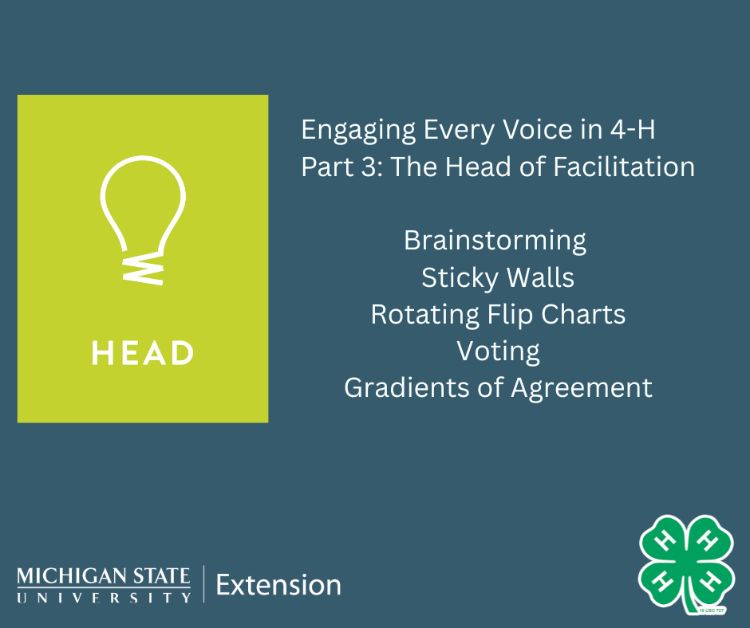Engaging every voice in 4-H: Part 3 – The head of facilitation
Exploring the third H (head) of facilitation for 4-H clubs.

In Michigan 4-H, volunteers are creating spaces where all youth feel heard and valued. One key to making this happen is strong facilitation—how we guide meetings, activities, and conversations. This four-part series, Engaging every voice in 4-H, takes a closer look at facilitation skills through the lens of the four H’s: head, heart, hands and health.
In this third article of the series, Michigan State University Extension provides tips to guide 4-H groups from ideas to action, focusing on how to get the most input, participation and engagement from all members of a 4-H club.
Successful 4-H meetings don’t happen by accident. Behind every productive discussion is a skilled facilitator who knows how to guide people through the process of sharing ideas, narrowing options and making decisions. This is where the “head of facilitation” comes in—using tools and strategies that help groups think clearly and work together effectively.
At the core of these skills is brainstorming, the first step in engaging everyone in the room. Brainstorming encourages participants to think outside the box and consider every possibility before rushing into decisions. Whether it’s through “popcorn” sharing, “Round Robin” responses, or fun approaches like “snowball” (tossing paper ideas into the mix), the goal is the same: make sure every voice is heard and every idea is captured.
But effective facilitation doesn’t stop there. Once ideas are on the table, they need to be organized and prioritized. Techniques like Sticky Walls—where ideas are written on cards or notes and grouped by theme—help participants see connections and focus on what matters most. Rotating flip charts allow small groups to contribute to different topics around the room, ensuring broad participation and a wealth of perspectives.
Decision-making strategies bring the process full circle. Sticky dot voting lets members show support for ideas in a simple, visual way, while gradients of agreement encourage 4-H members to share not just whether they agree or disagree, but how strongly they feel. These methods keep discussions balanced and help groups move forward with confidence in the decision.
The head of facilitation reminds us that good leadership is more than just managing a meeting—it’s about guiding members through thoughtful processes where creativity thrives, decisions are clear, and everyone feels included. By applying these practical techniques, any group can turn ideas into meaningful action while allowing all voices to be heard.
For the best success in engaging youth voices, review the additional articles in this series exploring the heart, hands and health of facilitation skills.



 Print
Print Email
Email


